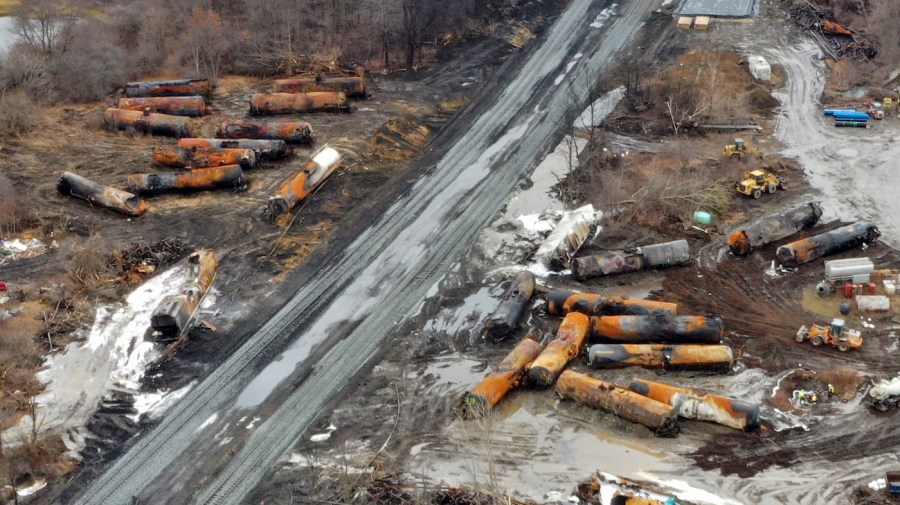Ohio Train Derailment: The Lingering Threat Of Toxic Chemicals

Table of Contents
The Immediate Aftermath and Initial Response to the Ohio Train Derailment
On February 3, 2023, a Norfolk Southern freight train carrying hazardous materials derailed in East Palestine, Ohio. Approximately 50 cars derailed, resulting in a massive fire and the release of numerous toxic chemicals, including vinyl chloride, butyl acrylate, and ethylene glycol monobutyl ether. The initial response involved the evacuation of thousands of residents within a one-mile radius of the derailment site. Cleanup efforts began immediately, focusing on containing the spread of chemicals and extinguishing the fire. However, the controlled burn of vinyl chloride, conducted to prevent a potential explosion, released phosgene and hydrogen chloride into the atmosphere, adding another layer of concern to the already dire situation.
- Initial reports of chemical releases: Vinyl chloride, a known carcinogen, was the primary concern, along with butyl acrylate, a potential respiratory irritant, and other hazardous substances.
- Controlled burns and their environmental consequences: While preventing a larger explosion, the controlled burn released additional toxic byproducts into the air and potentially into the surrounding environment.
- Criticism of the initial response and communication: Many criticized the initial response, citing a lack of transparency and inadequate communication with residents about the risks and potential long-term health effects.
- Lack of transparency and information sharing with residents: Concerns grew regarding the lack of readily available information regarding the extent of the contamination and the safety of returning home.
Long-Term Health Concerns from the Ohio Train Derailment Chemicals
The released chemicals pose significant long-term health risks to the residents of East Palestine and the surrounding areas. Vinyl chloride, in particular, is a known human carcinogen linked to various cancers, including liver cancer, brain cancer, and leukemia. Exposure to butyl acrylate can cause respiratory irritation, skin irritation, and eye problems. Other released chemicals may also cause a range of health issues.
- Respiratory issues: Asthma, bronchitis, and other respiratory illnesses are likely to increase among residents due to exposure to the released chemicals.
- Cancer risks: Long-term exposure to vinyl chloride and other carcinogens increases the risk of developing various types of cancer.
- Reproductive health concerns: Some of the released chemicals are suspected of impacting reproductive health, leading to concerns about birth defects and other reproductive issues.
- Neurological damage: Exposure to certain chemicals can lead to neurological damage, impacting cognitive function and other neurological processes.
- The need for comprehensive health screenings for residents: Long-term health monitoring and comprehensive screenings are crucial to assess the full extent of the health impacts and provide necessary medical care.
Environmental Contamination and Ecological Impacts of the Ohio Train Derailment
The Ohio train derailment has caused widespread environmental contamination, impacting soil, water, and air quality in the affected area. The contamination poses a significant threat to the local ecosystem and wildlife. Initial water testing revealed the presence of contaminants, raising concerns about drinking water safety and the potential for long-term water pollution. Soil samples also showed contamination, demanding extensive cleanup and remediation efforts.
- Water contamination testing and results: Ongoing water testing is crucial to monitor the extent of water contamination and ensure the safety of drinking water sources.
- Soil contamination analysis and remediation efforts: Extensive soil testing and remediation efforts are necessary to address the widespread soil contamination.
- Impact on local flora and fauna: The released chemicals have likely impacted local plant and animal life, with potential long-term consequences for biodiversity.
- Long-term ecological restoration challenges: Restoring the affected ecosystem will require significant long-term efforts and resources.
Regulatory Failures and Calls for Reform Following the Ohio Train Derailment
The Ohio train derailment exposed serious deficiencies in the existing regulations governing the transportation of hazardous materials. The debate surrounding the use of older, less-safe tank cars and the adequacy of current safety protocols highlights the need for comprehensive reform.
- Debate surrounding the use of older, less-safe tank cars: The use of older tank cars raises questions about the effectiveness of existing regulations and the need for stricter standards.
- Calls for stricter regulations on the transportation of hazardous materials: The derailment has intensified calls for stricter regulations and increased oversight of the transportation industry.
- Increased safety measures and training for railway workers: Improved safety measures and training for railway workers are essential to prevent future accidents.
- Improved emergency response protocols: More effective emergency response protocols are needed to ensure a quicker and more coordinated response to future derailments.
- Increased government oversight and accountability: Increased government oversight and accountability are necessary to enforce regulations and ensure the safety of hazardous material transportation.
Conclusion
The Ohio train derailment serves as a stark reminder of the potential dangers associated with the transportation of hazardous materials. The lingering threat of toxic chemicals necessitates a comprehensive and long-term response, addressing both the immediate health concerns of affected residents and the ongoing environmental remediation challenges. We must demand stronger regulations, improved safety protocols, and increased transparency from regulatory bodies and railway companies to prevent future disasters. Understanding the long-term consequences of the Ohio train derailment is crucial to advocating for meaningful change and preventing similar tragedies. Let's continue to demand accountability and push for stricter regulations concerning the transportation of hazardous materials to mitigate the risks of future Ohio train derailment-like events. We need a nationwide conversation about improving hazardous materials transport safety to prevent future crises.

Featured Posts
-
 Vizit Marka Bernsa Dukhovniy Sovetnik Trampa V Ukraine
Apr 25, 2025
Vizit Marka Bernsa Dukhovniy Sovetnik Trampa V Ukraine
Apr 25, 2025 -
 The Benefits Of Strong Middle Management For Companies And Employees
Apr 25, 2025
The Benefits Of Strong Middle Management For Companies And Employees
Apr 25, 2025 -
 From Behind To Top Bayern Munichs Bundesliga Winning Streak Continues
Apr 25, 2025
From Behind To Top Bayern Munichs Bundesliga Winning Streak Continues
Apr 25, 2025 -
 Finding Sanctuary A Refugee Familys Story Of Hope And Pope Francis Support
Apr 25, 2025
Finding Sanctuary A Refugee Familys Story Of Hope And Pope Francis Support
Apr 25, 2025 -
 Stagecoach 2025 A Look At The Potential Lineup Atmosphere And Highlights
Apr 25, 2025
Stagecoach 2025 A Look At The Potential Lineup Atmosphere And Highlights
Apr 25, 2025
Latest Posts
-
 Trumps Transgender Military Ban A Critical Analysis Of The Rhetoric
May 10, 2025
Trumps Transgender Military Ban A Critical Analysis Of The Rhetoric
May 10, 2025 -
 Understanding The Controversy Trumps Policy On Transgender Service Members
May 10, 2025
Understanding The Controversy Trumps Policy On Transgender Service Members
May 10, 2025 -
 Dissecting Trumps Transgender Military Ban Fact Vs Fiction
May 10, 2025
Dissecting Trumps Transgender Military Ban Fact Vs Fiction
May 10, 2025 -
 Bangkok Post The Ongoing Struggle For Transgender Rights And Equality
May 10, 2025
Bangkok Post The Ongoing Struggle For Transgender Rights And Equality
May 10, 2025 -
 News From The Bangkok Post Transgender Community Seeks Legal Reform
May 10, 2025
News From The Bangkok Post Transgender Community Seeks Legal Reform
May 10, 2025
